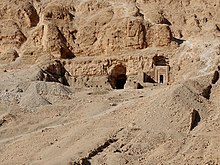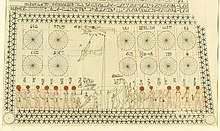TT353
TT353 (Theban Tomb 353 - Theben, Grab 353 ) is part of the two-part grave of the steward and official Senenmut , who played a special role under the Egyptian Queen Hatshepsut and was founded in 1472 BC. At the end of the 7th year of the reign of Hatshepsut began with the construction of his grave and his burial chapel . The liturgical transfiguration texts used in Senenmut's grave originally come from the Old Kingdom and were only reserved for kings ( pharaohs ) there.
As early as the Middle Kingdom, the texts present in the grave of Senenmut than copies of the Old Kingdom appeared in a private rocky grave ( Asyut ) at the time of I. Sesostris on. It is noteworthy that in the grave of Senenmut text passages from the literature of the dead of the Middle Kingdom are used, which in the Old Kingdom only appeared in cultic recitations that primarily had no reference to the liturgies of the dead.
Grave complex
The tomb is in the Theban necropolis near the Queen's mortuary temple in Deir el-Bahari . Egyptian tombs usually consist of two parts: the above-ground part (see e.g. mastaba ), in which the cult for the dead took place, and the underground part, in which the mummified corpse was buried. As a rule, both parts are close together. In the New Kingdom , however, it can be observed that the kings separated the two. Due to the use of motifs from the Middle Kingdom and innovations of the New Kingdom of the grave type, the grave complex can be classified as a "transitional grave".
Their underground tombs are located in the Valley of the Kings , while temples were built as cult facilities on the edge of the desert. Some officials also copied this spatial separation of the grave and the cult complex. A decorated burial chapel by Senenmut is known ( TT71 ), but it does not have a burial chamber. This burial chamber was found in grave TT353, which now has no above-ground cult site and only consists of a very long underground passage that led to the burial chamber after approx. 80 m.
TT353 is completely carved into the rock. The entrance is in a hollow, east of the temple of Hatshepsut . The grave complex is about 90 m long. A staircase leads down from east to west. After about 45 m there is a small door on the south side that leads into a small chamber. After another 10 m, the main course opens into a chamber (A). It is the only decorated chamber in the tomb. The walls have been clad with limestone . Irregularities are repaired with plaster of paris. The center of the decoration is a false door on the west side, which is partially decorated with the saying 148 of the Book of the Dead. The remaining wall surfaces are also inscribed with sunk reliefs from the Book of the Dead .
A staircase leads from chamber A about 25 m further to the completely undecorated chamber B. A third chamber (C) follows after another 10 m and is again completely undecorated.
Astronomical ceiling representations
A special feature is a decorated chamber after approx. 50 m. On the walls and ceilings there are texts from the Book of the Dead and unfinished astronomical calendar entries which, as the first representatives of Dean Lists C, are based on the templates of the Deans Lists A2 of the Middle Kingdom (Asyut).
Another to the year 1463 BC. The star clock, dated to the 3rd century BC, forms the beginning of the group C star clocks due to the fact that it is used for the first time in the grave of Senenmut, compared to the otherwise common diagonal star clock of the Middle Kingdom. The " Star of the King and Osiris " mentioned in this context culminated in 1463 BC. BC in ancient Egypt on 23rd and 24th Achet III at the 7th hour of the night ( midnight ) and symbolized the rebirth of the deceased.
Such representations were often used as copied templates for grave ceiling representations on the Ramesside star clocks at least until the Ramesside period . The astronomical constellations depicted in Senenmut's tomb were adopted to the exact day, although the astronomical events in the Egyptian calendar had meanwhile shifted.
See also
literature
- Peter F. Dormann: The monuments of Senenmut: problems in historical methodology. Kegan Paul International, London / New York 1988, ISBN 0-7103-0317-3 .
- Christian Leitz : Ancient Egyptian star clocks. Peeters, Leuven 1995, ISBN 90-6831-669-9 .

